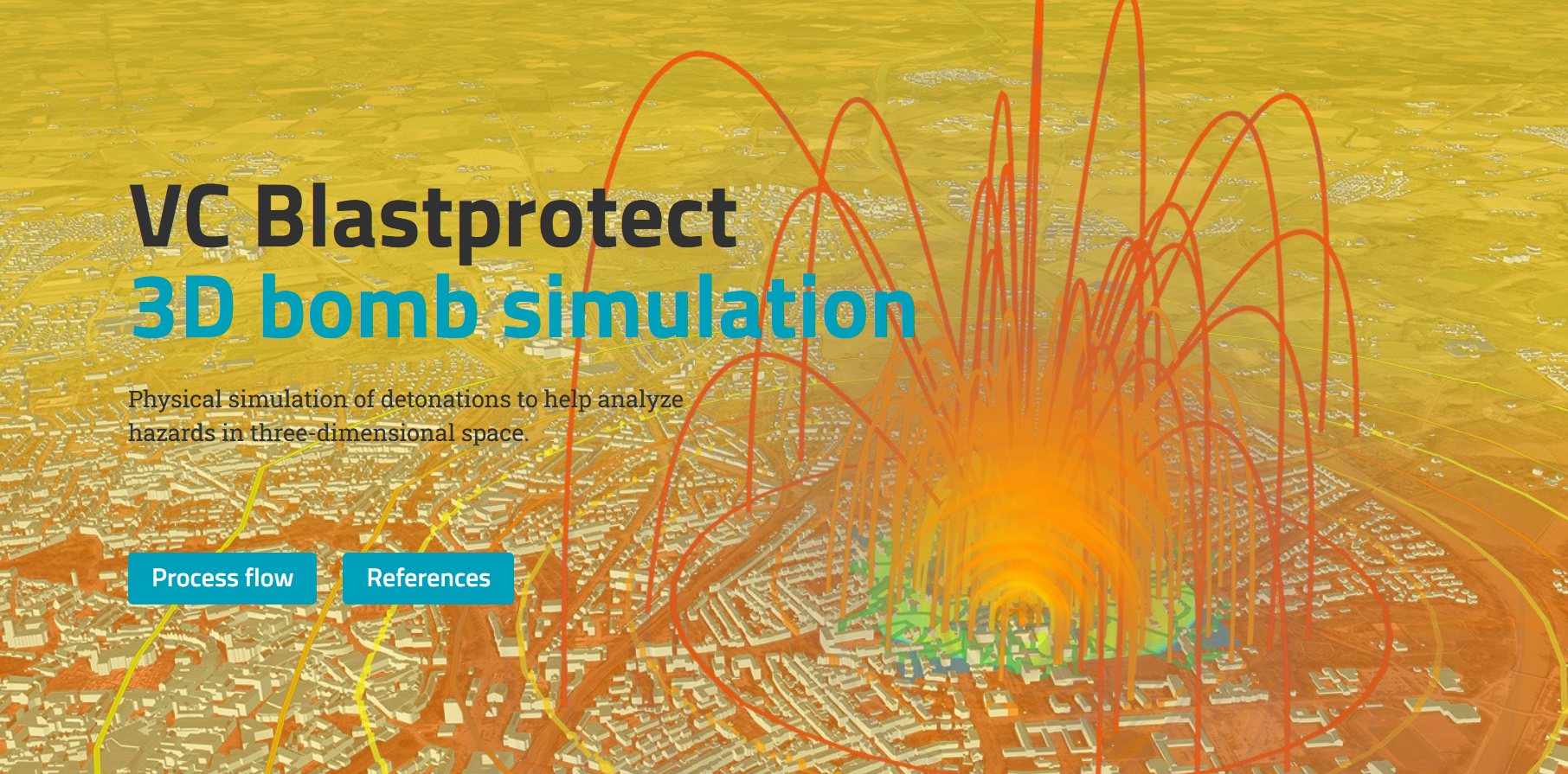About APOLLO
The APOLLO Blastsimulator is a specialized CFD-tool dedicated to the simulation of explosions, blast waves and gas dynamics. It is being developed with the objective to offer a unique combination of
- sophistication and suitability of models and methods.
- short computing times and high accuracy.
- high level of usability through practically relevant options.
The APOLLO Blastsimulator is being developed since 2010 for engineers working in the fields of defense, public safety and industrial safety.

High-resolution near field simulation of an exploding cylindrical charge
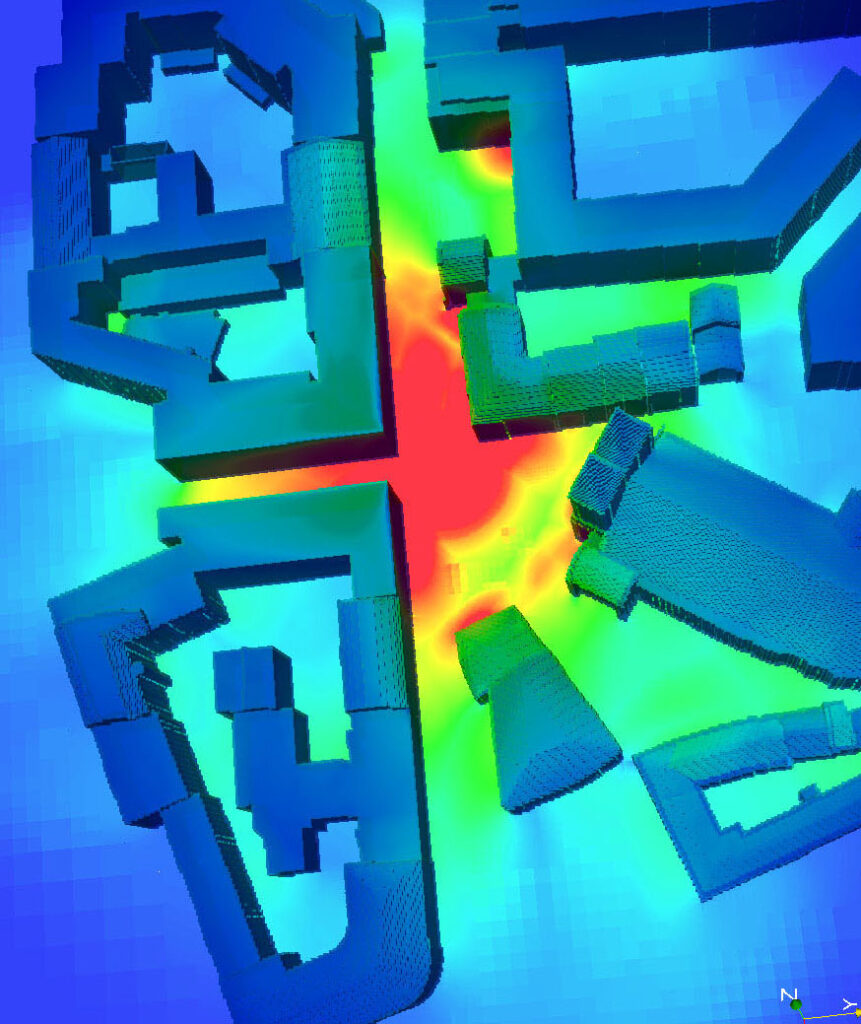
Pressure distribution from explosion in urban environment
Physical models
The fundamental physical models are the conservation equations for transient flows of inviscid, chemically reacting, compressible fluids. Equations of state (EOS) and reaction models define the thermodynamic properties of the fluids.
Fluids can be gases or liquids. Implemented EOS models are perfect gas, JWL, linear and Tait with cavitation. Reaction models comprise propagation models such as Burn-On-Time, Chapman-Jouguet (Detonation), Constant-Flame-Speed (Deflagration) and different kinds of combustion models for afterburning of explosives.
All EOS and reaction models are readily parameterized for a relevant selection of materials, such as Air, Water, TNT and many more.

Conservation equations for a material volume

Conservation equations for arbitrary control volumes.
Right hand side consists of Lagrange- and Remap operator
Numerical Method
Simulations are achieved through time-integration of the conservation equations on user-defined computational domains furnished with boundary- and initial conditions.
The APOLLO Blastsimulator uses an explicit time integration and a finite-volume discretization on uniform Cartesian grids.
The time integration is split in two operators: each time step consists of a Lagrange step, which refers to a material volume, and a subsequent remapping step, which maps the result of the Lagrange step back onto the original grid cell. This two-step scheme provides an Eulerian integration and is well suited for multi-phase flows or strongly non-linear equations of state.
Multi-Fluid-Simulations
If a simulation comprises unmixable fluids, like water and air, the spatial distribution of these fluids within a grid cell is reconstructed from the volume fractions in the cell and its neighbors. This enables transport of fluids without artificial diffusion.
Aside from the volume fractions, the individual states of each fluid in a grid cell must be available. This is a prerequisite for physically meaningful time integration of mixed cells.
For an efficient treatment of such cases single-volume-of-fluid (SVOF) and multi-volume-of-fluid (MVOF) cells are distinguished in both procedures and data structures. While SVOF cells may contain single fluids or gas mixtures which occupy the entire cell, MVOF cells contain multiple, spatially separated fluids with individual states and volume fractions.
The MVOF method in APOLLO permits a physically appropriate, accurate and robust simulation of multi-fluid flows. It is applied for detonation of explosives and for liquid-gas interaction.
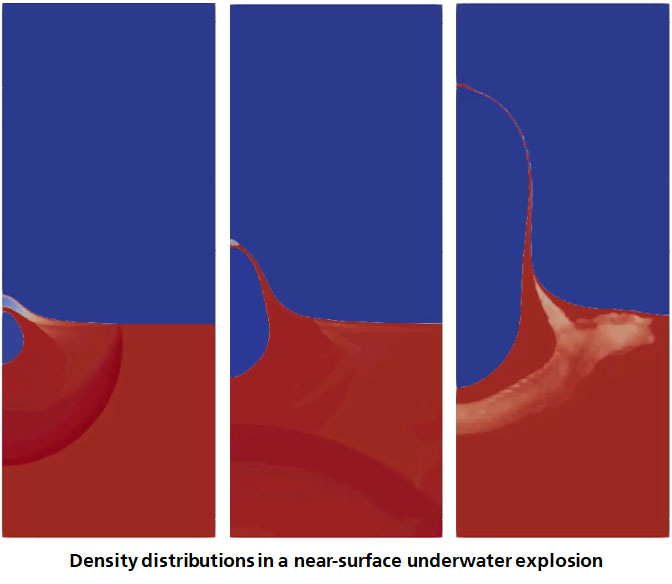
Geometric Modelling
The APOLLO Blastsimulator uses uniform Cartesian grids. Computational domains are either single box-shaped regions or multi-part assemblies of box-shaped regions. Geometrical objects can be modelled by placement of wall-boundary conditions inside of the domain or on domain boundaries.
Structures with arbitrary geometry can be modelled as embedded objects by blocking off whole grid cells. Such objects constitute so-called voxel models.
Model generation is done with the APOLLO-MOD module: embedded objects can be constructed by application of pre-defined geometry models like boxes, cylinders, tubes any many more. Further to this, embedded objects can be automatically derived from imported STL models, where geometrical transformations (scale, shift, rotate) may be applied.
Aside from wall boundary conditions, the user can apply open (artificial) boundaries with low-reflection properties and selectable far-field states.

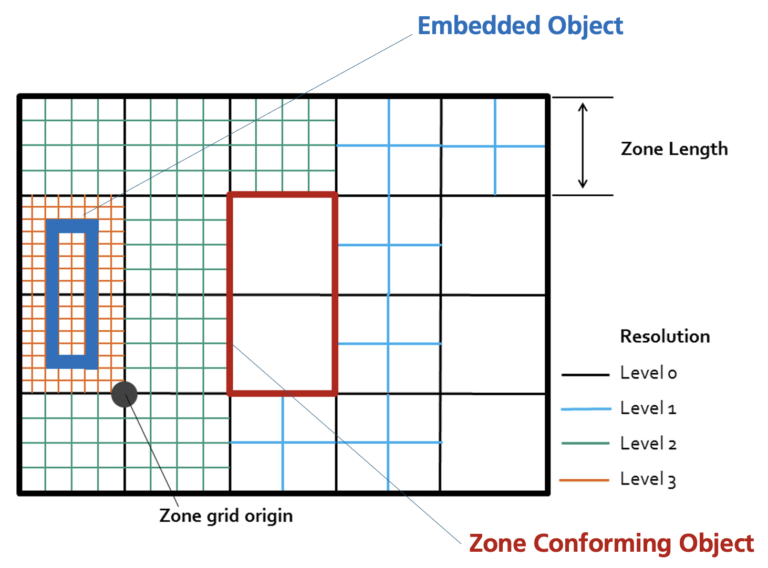
Illustration of DMA concept
Dynamic Mesh Adaption
Fast and memory-efficient simulations with high resolution rely on the dynamic mesh adaption (DMA) capability of the APOLLO Blastsimulator. It is based on a zonal concept, where uniform Cartesian sub-grids with resolution 2n cells per zone edge can be inserted into any zone.
Zone length and the highest resolution level used in a simulation are user-defined parameters. Geometrical objects are persistently embedded as voxel models on the highest resolution level.
The resolution level in each zone is automatically determined for each time step from the gradients of selected flow fields in each zone. The sophisticated algorithm permits a mesh adaption with outstanding quality.
Zoom Option
A challenge for any blast simulation is the adequate treatment of length scales: the explosive charge and the detonation wave length are the features to be resolved initially. As the wave length of the evolving blast wave increases, the requirement for spatial resolution becomes less severe in time.
The zoom concept has been developed to cope with this challenge. It enables a temporary increase of resolution level in the DMA algorithm within a spherical region (zoom region). The zoom application can consist of several stages: In each stage the zoom level is reduced while the zoom region is enlarged until the regular resolution level is reached.
Parameterization of the zoom process is either automatic (based on charge position and size) or user-defined. Multiple zoom regions can be defined within a simulation.
Aside from the zoom option further options exist, which permit to control the resolution in different regions of the domain.
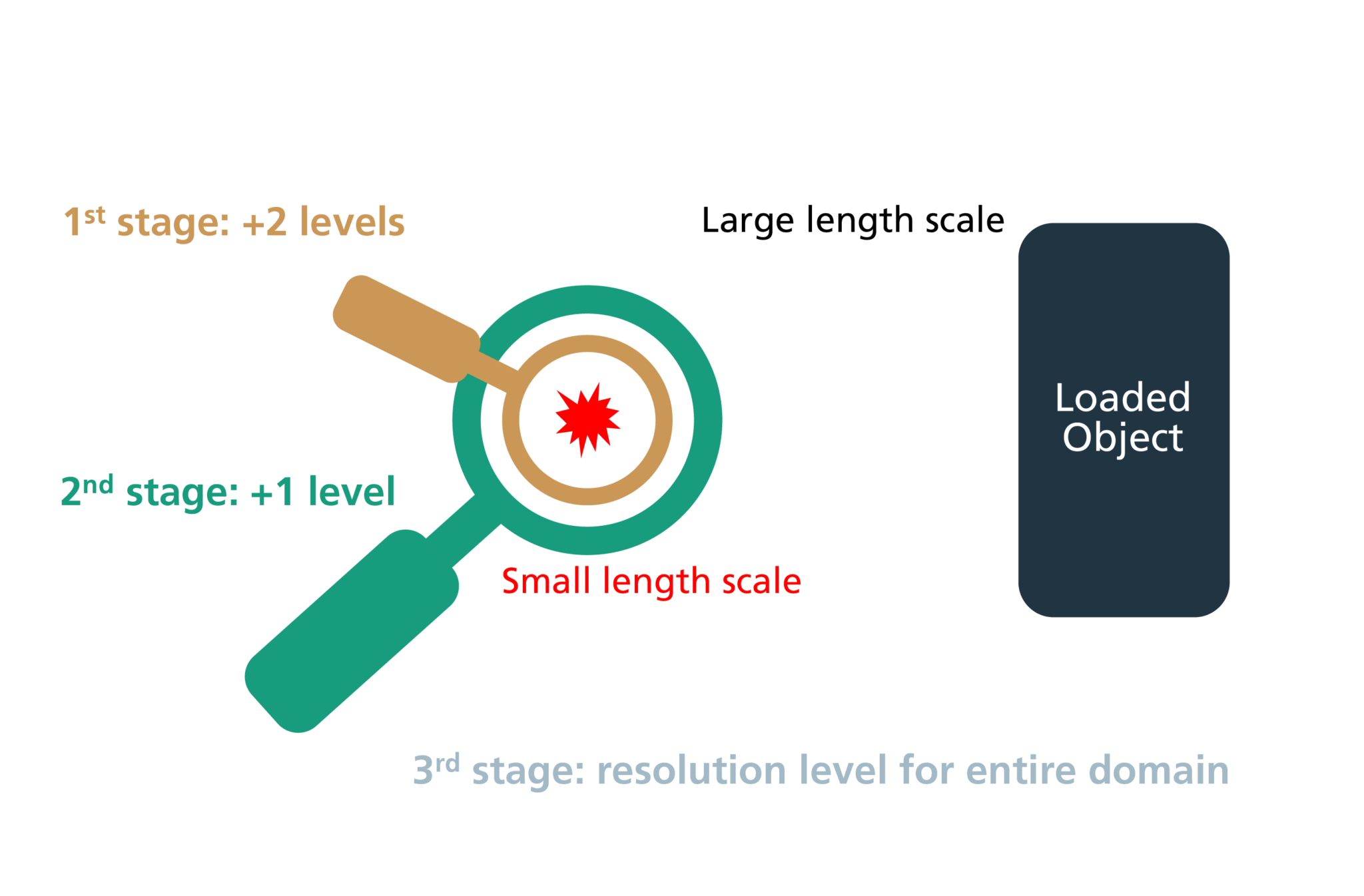
Charge Specification
Initial spatial distributions of fluids with specified states can be set by predefined geometrical objects. This includes the positioning of initiation points for chemical reactions. Thereby charges of arbitrary geometry and any number of initiation points can be constructed.
As a shortcut to this, simple spherical, hemispherical or cylindrical charges can be defined and positioned in terms of mass, center point, orientation and initiation mode. This option can be applied for one or more charges and permits an automatic application of zooming for these charges.
Stage Processing
In many cases the initial phases of an explosion can be reasonably well approximated in 1D spherical symmetry up to a time when the blast wave reaches an object. For such cases APOLLO-B1D permits a very fast and highly resolved simulation for the initial phase. In a staged simulation, the flow field obtained at the end of a B1D simulation is automatically remapped into the 3D model and the simulation is continued with APOLLO-B3D without any user interaction being required. A staged simulation can be combined with application of zoom to render a most efficient high-resolution simulation.

Fragmentation of a projectile upon perforation of a plate
Fluid-Particle Interaction
The simulation of fluids can be coupled to a chemically reacting or inert particle phase. This permits the simulation of dust or other dilute particle phases interacting with a fluid phase.
Particles are modelled in APOLLO as discrete mass points; the interaction with the fluid occurs through momentum-, heat- and mass- transfer. Particles may interact with embedded objects through elastic-plastic impact but not with other particles.
Fluid-Structure Interaction

Fragmentation of a explosive-filled steel ring
The APOLLO Blastsimulator has its own co-simulation interface which permits a time-resolved, two-way coupling with any structural-dynamics solver equipped with the same interface. The coupling is achieved through data exchange:
- the structural dynamics solver provides the exposed surface of the structure (the coupling surface) to the APOLLO Blastsimulator
- it receives the pressure distribution on this surface in return.
The data exchange is performed repeatedly at synchronized times and is realized via two distinct files or named pipes.
The coupling surface is approximated in the APOLLO Blastsimulator as a dynamic voxel model, similar to the static voxel models derived from imported STL geometries. The coupling surface has a velocity attributed to its surface and may experience displacement, deformation and fragmentation.
Interfaces are currently available for LS-DYNA and SOPHIA (Fraunhofer EMI).
Solver Modules
The APOLLO Blastsimulator consists of the following modules:
- APOLLO-MOD: Model Generator
- APOLLO-B1D: 1D Spherical Simulation
- APOLLO-B3D: 3D Simulation
All modules are included in a single executable and controlled by a single common input file.
Distinct from open source software projects the APOLLO Blastsimulator is “ready to use”. Versions for Linux and for Windows are available.
Parallelization and required Hardware
APOLLO is parallelized for multi-core CPU using OpenMP and can be run on any number of cores which share the same memory. A CPU with eight or more cores and memory of at least 64 GB is recommended.
Manual and Examples
Applied concepts, relevant details of the methods and input parameters, physical models (EOS- and Reaction models) and file formats are documented in the manual.
Aside from the manual there are 15 prepared examples included in the package which feature applications with various aspects and options.
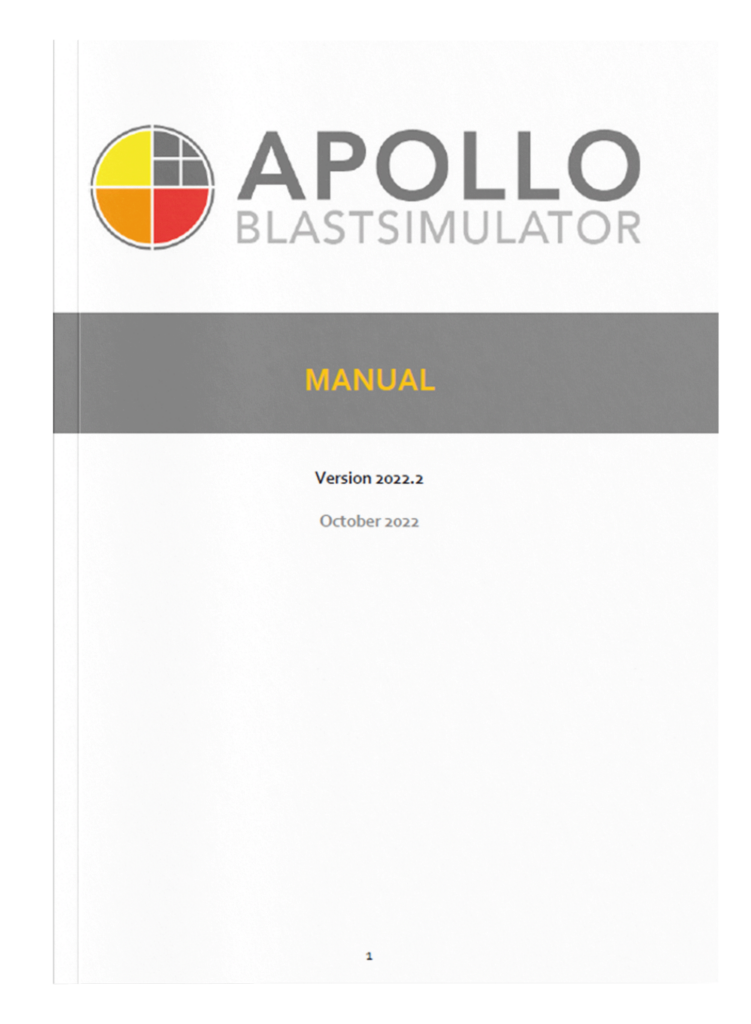
Output and Postprocessing
Apollo generates VTK-formatted plot-files customized for the visualization of models and simulation results with Paraview. Outputs comprise surface- or volume-plot series with user-definable contents and sampling rates. Additional plot files are available for visualization of gauge- and initiation positions and for the distribution of peak-overpressures, impulses and blast effects on model surfaces.
Aside from the plot files, history files are produced which can be loaded into Gnuplot, Excel or other tools to create curve-plots.
History files are created for gauges (local flow states), forces (pressure integral over part surfaces), parts (regions of the domain) and global data (e.g. total mass inventories and global extrema of state variables). Gauges can either be fixed in space, fixed to a moving object or moving with the fluid.
Graphical User Interface
The setup of simulation cases and the launching and monitoring of simulations is supported by a graphical user interface (GUI). The GUI also includes postprocessing of history data (curve plots).
For model and flow field visualizations the APOLLO Blastsimulator relies on freely available tools like Paraview (paraview.org).

Snapshot of a GUI page
Licenses
The licensed software is protected by a USB-dongle.
Annual licenses can be issued for a workplace or for a network.
A single license for a workplace permits the concurrent execution of any number of applications on a single computer, while a single license for a network permits only one application at a time on any computer in the network. Multiple workplace licenses or network licenses for multiple applications are offered as extensions to a single license.
For information on prices please contact us.
The software is export controlled.
VC Blastprotect
APOLLO Blastsimulator and APOLLO Fragsimulator are the simulation engines behind the risk assessment tool VC Blastprotect for explosive ordnance disposal. VC Blastprotect permits a quantitative risk assessment concerning the hazards caused by blast and fragments to people and buildings in urban environments:
- VC Blastprotect utilizes digital city models
- The APOLLO Blastsimulator is employed to determine the distribution of pressure amplitudes and impulses in the urban environment. Hazards are estimated based on selected P-I-curves.
- The APOLLO Fragsimulator enables the determination of the distribution of fragment impact probabilities and associated hazards for people. It uses pre-calculated fragment matrices and takes into account bomb position and orientation.
VC Blastprotect is developed in cooperation with Virtual City Systems – see link below figure for more details.
APOLLO Blastsimulator
since 2010 for engineers working in the fields of defense, public safety and industrial safety


